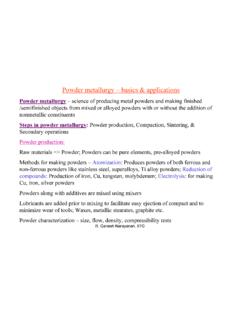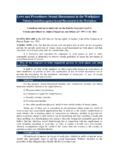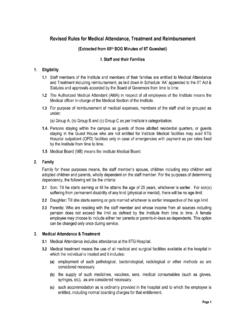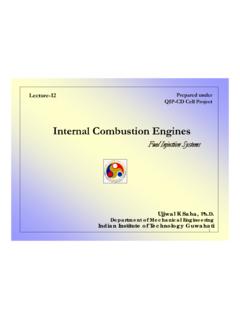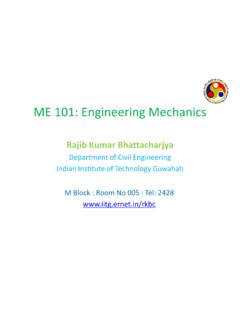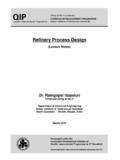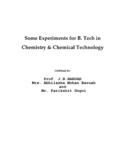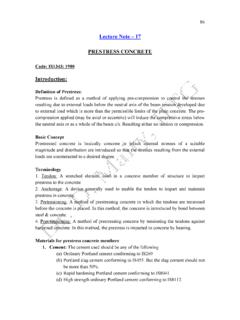Transcription of Some Experiments for M. Sc in Inorganic Chemistry
1 1 some Experiments for M. Sc in Inorganic Chemistry COMPILED BY: Prof. Mr. Parikshit Gogoi and Mrs. Abhilasha Mohan Baruah 2 Course Name: Inorganic Chemistry Laboratory Expt. No. 1: Study of a redox reaction: Standardization of potassium permanganate by oxalic acid Expt. No. 2: Metal ion estimation: Quantitative estimation of copper (II), calcium (II) and chloride in a mixture Expt. : Colorimetry: Simultaneous determination of chromium and manganese in a solution by visible spectroscopy.
2 Expt. : Co-ordination complex: Synthesis and characterization of potassium tris-oxolato chromate (III) trihydrate Expt. : Solid phase synthesis of trans-bis glycinato copper(II). Expt. : Synthesis and characterization of tris-triphenylphosphine copper(I) nitrate Expt. : Ligand synthesis for multimetal complex: Preparation of bis-(N,N-disalicylidene ethylenediamine) -aquo-dicobalt Expt. : Non-metal complex: Synthesis and characterization of bis-pyridine iodide nitrate Expt. : Synthesis of penta amminechlorocobalt(III)chloride Expt.
3 : Preparation of tetrabutylammoniumoctamolybdate(VI) . Expt. : Preparation of tris-acetylacetonato iron (III). Expt. : Nano- Chemistry : Preparation of manganese dioxide nano-particles Expt. : Synthesis of copper (II) complex of 5, 7, 7, 12, 14, 14-hexmethyl-1, 4, 8, 11-tetraazacyclo tetra deca-4, 1, 1-dinene with perchloric acid Expt. : Preparation of cis and trans-dichloro bis (ethylenediamine) cobalt (III) chloride Expt. : Preparation of bis-(diisopropylamine) chloro phosphate Expt. : Preparation of bis-dichlorotriphenyl phosphine nickel (II) Expt.
4 : Synthesis of hexaammine cobalt(III) chloride Expt. : Preparation of potassium bis(peroxo)-oxo- (1, 10-phenanthroline) vanadium (V) trihydrate Expt. : Preparation of tetra-butylammoniumhexa molybdate (VI) 3 experiment Standardization of potassium permanganate by oxalic acid: Commercially available potassium permanganate generally contains impurity. Thus it cannot be used as a primary standard. In order to make standard potassium permanganate solution it requires standardized by a primary standard. Equivalent weight of KMnO4 = [ 2 KMnO4 /10 ] = , which is derived from the equation 2 KMnO4 = K2O +2 MnO, Mn+7 + 5 e Mn+2 Preparation of potassium permanganate: Weigh potassium permanganate ( g) with an ordinary balance.
5 Take the weighed potassium permanganate in a beaker (250 ml). Add distilled water (100 ml); cover the beaker with a watch glass, heat the solution to boiling, and allow it to cool to the room temperature. Filter the solution through a funnel containing glass wool. The filtered solution should be stored in a stopper clean; glass bottle. The solution should be stored in the dark except when in use. Standardization: 1. Rinse a clean burette (50 ml) thrice with 5 ml portions of the potassium permanganate solution.
6 Fill up the burette with potassium permanganate solution up to the zero mark, note the upper meniscus. Examine that the jet of the burette is completely filled with the solution and no air bubble is left behind. 2. Prepare a solution of sulphuric acid (1:2): Add conc. sulphuric acid (10 ml) to water (10 ml) with stirring and cooling if necessary. Precautions: Heat is evolved during mixing so care is to be taken. (Discuss with laboratory staff or supervisor) 3. Pipette out standard oxalic acid ( , 10 ml) into a beaker (250 ml).
7 Add sulphuric acid (1: 2 in water, 10-15 ml) and then add boiling water to dilute it to about 100 ml. Now titrate the solution with potassium permanganate solution. At first add potassium permanganate solution small quantities at a time with stirring; the pink color of potassium permanganate will take some time to discharge its colour at the beginning. So initial addition should be very slow. When some potassium permanganate solution has been added, the pink color will be discharged quickly. Now add potassium permanganate solution more quickly with stirring.
8 Near the end point when the rate of disappearance of the pink color slows down, add potassium permanganate solution drop wise with stirring until with one drop makes the whole solution pink. (The pink color persists for 30 seconds, after which the color may be discharged again). 4. Note the volume of potassium permanganate solution added. Repeat the operation thrice. Calculations: Let volume of KMnO4 solution = V1 ml, Strength of oxalic acid = S1 (N) Therefore, strength of KMnO4 solution = (10 x S1) / V1 (N) 4 experiment Quantitative estimation of copper (II), calcium (II) and chloride from a mixture: In this experiment the chloride ion is separated by precipitation with silver nitrate and estimated.
9 Whereas copper(II) is estimated by iodometric titration and Calcium by complexometric titration Iodometric estimation of copper (II): Copper solution oxidizes potassium iodide and liberates iodine; liberated iodine is estimated by sodium thiosulphate. The reactions involved are: 2 Cu2+ + 4I- 2Cu+ + 2I2 and 2I2 + 2S2O32- 2I- + S4O62- Complexometric estimation of calcium (II): During the complexometric titration of calcium (II), copper (II) ion can interfere if eriochrome black-T indicator is used.
10 So copper (II) is reduced to copper (I) by using hydrazine hydrate and precipitated as copper thiocyanate by using ammonium thiocyanate. A calcium (II) ion is then titrated with ethylene diamine tertraceetic acid (EDTA). Ca2+ + H2 Y2- CaY2- + 2H+ , where YH4 is EDTA No sharp end point can be obtained for calcium (II) with eriochrome black-T indicator, so small amount of Mg-YH2 should be added to get a sharp end point. Gravimetric estimation of chloride: Chloride can be estimated gravimetrically by precipitating it as silver chloride.
